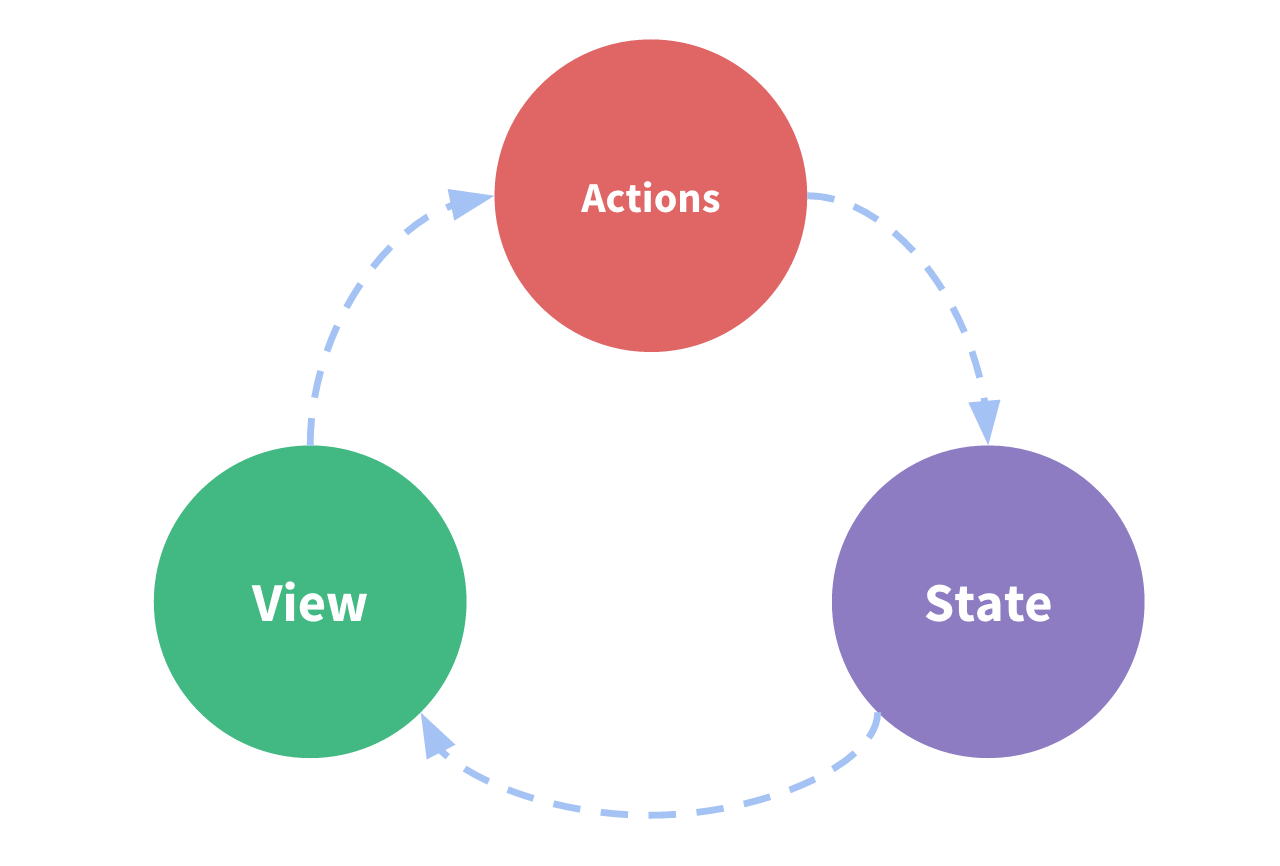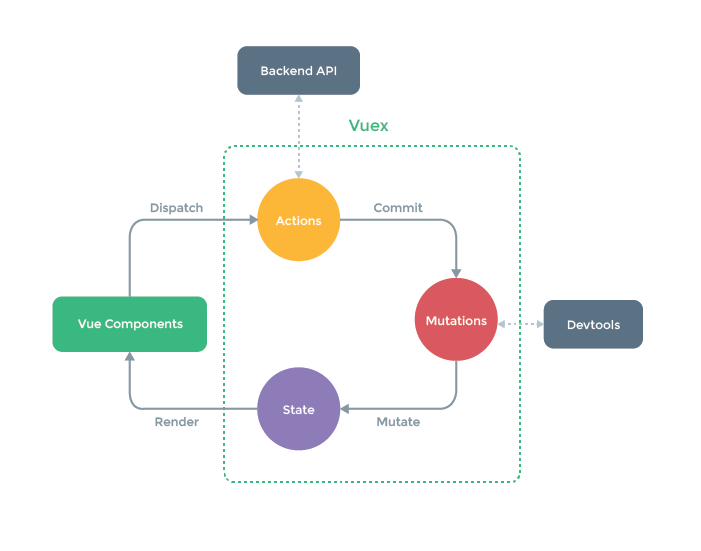What is Vuex?
Vuex is a state management pattern + library for Vue.js applications. It serves as a centralized store for all the components in an application, with rules ensuring that the state can only be mutated in a predictable fashion. It also integrates with Vue’s official devtools extension to provide advanced features such as zero-config time-travel debugging and state snapshot export / import.
What is a “State Management Pattern”?
Let’s start with a simple Vue counter app:
new Vue({
// state
data () {
return {
count: 0
}
},
// view
template: `
{{ count }}
`,
// actions
methods: {
increment () {
this.count++
}
}
})
It is a self-contained app with the following parts:
- The state, the source of truth that drives our app;
- The view, a declarative mapping of the state;
- The actions, the possible ways the state could change in reaction to user inputs from the view.
This is a simple representation of the concept of “one-way data flow”:

However, the simplicity quickly breaks down when we have multiple components that share a common state:
- Multiple views may depend on the same piece of state.
- Actions from different views may need to mutate the same piece of state.
For problem one, passing props can be tedious for deeply nested components, and simply doesn’t work for sibling components. For problem two, we often find ourselves resorting to solutions such as reaching for direct parent/child instance references or trying to mutate and synchronize multiple copies of the state via events. Both of these patterns are brittle and quickly lead to unmaintainable code.
So why don’t we extract the shared state out of the components, and manage it in a global singleton? With this, our component tree becomes a big “view”, and any component can access the state or trigger actions, no matter where they are in the tree!
By defining and separating the concepts involved in state management and enforcing rules that maintain independence between views and states, we give our code more structure and maintainability.
This is the basic idea behind Vuex, inspired by Flux , Redux and The Elm Architecture . Unlike the other patterns, Vuex is also a library implementation tailored specifically for Vue.js to take advantage of its granular reactivity system for efficient updates.
If you want to learn Vuex in an interactive way you can check out this Vuex course on Scrimba , which gives you a mix of screencast and code playground that you can pause and play around with anytime.

When Should I Use It?
Vuex helps us deal with shared state management with the cost of more concepts and boilerplate. It’s a trade-off between short term and long term productivity.
If you’ve never built a large-scale SPA and jump right into Vuex, it may feel verbose and daunting. That’s perfectly normal - if your app is simple, you will most likely be fine without Vuex. A simple store pattern may be all you need. But if you are building a medium-to-large-scale SPA, chances are you have run into situations that make you think about how to better handle state outside of your Vue components, and Vuex will be the natural next step for you. There’s a good quote from Dan Abramov, the author of Redux:
Flux libraries are like glasses: you’ll know when you need them.
Getting Started with Vuex
At the center of every Vuex application is the store. A “store” is basically a container that holds your application state. There are two things that make a Vuex store different from a plain global object:
- Vuex stores are reactive. When Vue components retrieve state from it, they will reactively and efficiently update if the store’s state changes.
- You cannot directly mutate the store’s state. The only way to change a store’s state is by explicitly committing mutations. This ensures every state change leaves a track-able record, and enables tooling that helps us better understand our applications.
The Simplest Store
NOTE: We will be using ES2015 syntax for code examples for the rest of the docs. If you haven’t picked it up, you should !
After installing Vuex, let’s create a store. It is pretty straightforward - just provide an initial state object, and some mutations:
// Make sure to call Vue.use(Vuex) first if using a module system
const store = new Vuex.Store({
state: {
count: 0
},
mutations: {
increment (state) {
state.count++
}
}
})
Now, you can access the state object as store.state, and trigger a state change with the store.commit method:
store.commit('increment')
console.log(store.state.count) // -> 1
Again, the reason we are committing a mutation instead of changing store.state.count directly, is because we want to explicitly track it. This simple convention makes your intention more explicit, so that you can reason about state changes in your app better when reading the code. In addition, this gives us the opportunity to implement tools that can log every mutation, take state snapshots, or even perform time travel debugging.
Using store state in a component simply involves returning the state within a computed property, because the store state is reactive. Triggering changes simply means committing mutations in component methods.
Here’s an example of the most basic Vuex counter app.
#vue #vuejs #vuex
